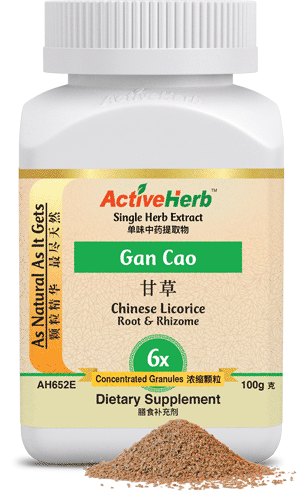Spring Forward With Sweetness & Fill Your Plate With Gan Foods.

On March 20, 2024, the first full day of Spring, it certainly didn’t feel like Spring had officially arrived—at least not in Buffalo, where the high temperature was 36 degrees. Mercifully, by the 25th, the mercury climbed to veritable springtime bliss (at least for Buffalo), with high temperatures in the 50s, which would cause residents of San Diego—ActiveHerb headquarters—to bundle up in beanies and Ugg boots.
No matter where you live, now that it’s Spring, it’s time to stop eating the rich comfort food (like Buffalo wings) that sustained us through the long winter. According to TCM principles, ‘tis the season to eat lots of sweet foods. But don’t get the wrong idea…
Spring In TCM
Springtime isn’t just about stopping to smell the budding roses. It’s a period of renewal and rejuvenation, not only in nature but also within our bodies. According to Traditional Chinese Medicine (TCM) principles, transitioning from the dormancy of winter to the vibrant energy of spring requires special attention to diet and lifestyle. According to TCM’s Five Element Theory, spring corresponds to the “wood” phase, with the Liver as the associated Zang organ. (Zang organs are Yin, solid, vital organs that store essential substances and regulate physiological processes.)
Sweet, Not Sour In Spring
Thus, to support the Liver, the TCM organ that represents Spring, it helps to eat specific foods that promote Yin/Yang balance in the Liver meridian. According to Thomas Avery Garran, a.k.a. the “Herb Whisperer” and director of East West School of Herbology, in Western herbology, springtime is commonly associated with eating bitter to awaken the Liver’s detoxification capacity, which is impaired after eating typical heavy winter foods.
However, Garran says that instead of eating bitter foods in Spring, the emphasis should be on incorporating sweeter foods into the diet. This does not give you full license to eat many heavily processed foods with added sugars, like pastries and candy. Rather, eat foods that don’t necessarily taste sweet but do have sweet properties, or “Gan,” one of the 5 tastes of TCM, and the taste associated with Spring, according to 5 Element Theory.
So, why should you reduce bitter and sour foods during spring, setting aside the fact that “Gan” is the TCM taste profile for the season? From a TCM theory perspective, this is an interesting question because sour flavors have an affinity for the liver. However, spring’s expansive, revitalizing attributes call for reducing sour tastes. Sour foods possess astringent qualities that may constrict the body’s energy flow—a stark contrast to the season’s expansive energy. Decreasing sour foods facilitates the smooth flow of Qi (vital energy) and encourages the body’s natural transition into the vibrant springtime state.
Furthermore, Gan foods nourish Yang (warming) Qi, but only if you eat wholesome foods. Unlike the sugary confections often associated with sweetness, Gan foods provide sustained energy and vital nutrients necessary for the body’s emergence from winter’s dormancy. Our metabolisms may not enter a true hibernation in winter, but compared to the rest of the year, it can sure feel like it.
Foods to Eat During Spring
- Fresh Greens: Leafy greens such as spinach, kale, and chard offer a burst of vitality and essential nutrients, promoting liver function and detoxification. Steam or bake these veggies rather than eating them raw so your Spleen organ system can easily transform the nutrients into Qi and Blood.
- Sprouted Grains: Choose sprouted grains like quinoa, barley, and millet. These are easier to digest and richer in nutrients, supporting the body’s transition from winter stagnation to springtime vitality.
- Root Vegetables: Carrots, sweet potatoes, and beets are grounding and nourishing. They provide a steady source of energy while supporting Liver health and blood circulation.
- Legumes: Lentils, chickpeas, and mung beans are excellent sources of plant-based protein and complex carbohydrates, promoting sustained energy levels and supporting the body’s natural detoxification processes.
- Fresh Fruits: Incorporate seasonal fruits such as strawberries, apricots, and cherries, which not only satisfy the palate but also provide essential vitamins, minerals, and antioxidants necessary for springtime vitality.
- Lean Meats: Choose lean cuts of poultry, fish, and pork to provide high-quality protein and essential amino acids, supporting muscle growth and overall vitality during the spring season.
- Herbal Teas: Enjoy herbal teas infused with ingredients like dandelion, burdock, ginger, and licorice root, which in Chinese is called Gan Cao, owing to its sweet properties. These teas promote liver detoxification and aid digestion, helping the body adjust to the energetic shifts of spring. These teas can be made instantly with ActiveHerb single herb extract granules.
Sweet Foods For Detoxification
In Western medicine, detoxification involves a complex, three-phase operation involving cytochrome P450 (CYP450) enzymes, conjugation of reactive metabolites, and transporting toxins out of the liver and into the blood and bile for excretion. Complex, indeed.
TCM theory, meanwhile, focuses on a few primary factors in regard to liver detoxification:
Nourishing Liver Yin
Gan foods possess a nourishing quality that helps replenish Liver Yin, which plays a crucial role in detoxification. According to TCM principles, the Liver stores Blood and regulates the smooth flow of Qi. When liver yin is deficient, it can lead to stagnation and impaired detoxification processes.
Sweet foods provide the essential nutrients and moisture needed to nourish Liver Yin, promoting optimal detoxification function. Quinoa, beans and tubers may not taste
sweet in the typical Western sense of added sugars. But having a better Liver function has a sweetness all its own.
Balancing Liver Qi
The liver’s detoxification function relies on the smooth circulation of Qi throughout the body. When liver Qi becomes stagnant or imbalanced, it can hinder the body’s ability to eliminate toxins efficiently. Sweet-flavored foods help regulate and harmonize Liver qi, ensuring smooth flow and detoxification.
Supporting Smooth Blood Flow
This is the same principle as harmonizing Liver Qi. Qi is the key driver of Blood. As the “general” of Qi circulation in the body, the Liver is also responsible for storing and regulating blood.
Supporting Bile Flow
Produced by the liver, bile helps the body absorb fats and fat-soluble vitamins and eliminates toxins. Sweet-property foods, particularly those rich in fiber and essential nutrients, stimulate bile production and promote healthy digestion. Incorporating foods such as leafy greens, whole grains, and fruits into your diet can help enhance bile flow, supporting the liver’s detoxification function and improving overall digestive health.







